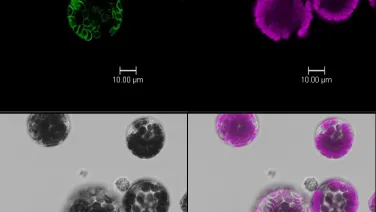PS Seminar Series: Translation with a minimal set of tRNAs - chloroplasts as model for manipulating isoacceptor tRNA abundance
In chloroplasts of embryophytes, superwobbling between codons and anticodons has been demonstrated to facilitate translation of the standard genetic code by a minimized set of only 30 tRNAs (Rogalski et al., 2008).
Speakers
Event series
Content navigation
Description

Abstract: In chloroplasts of embryophytes, superwobbling between codons and anticodons has been demonstrated to facilitate translation of the standard genetic code by a minimized set of only 30 tRNAs (Rogalski et al., 2008). In a systematic reverse genetic approach it was shown that five of these 30 tRNA species are not essential in tobacco chloroplasts (Rogalski et al., 2008; Alkatib et al., 2012). Each of these knocked out non-essential tRNAs is complemented by an essential isoacceptor tRNA that has an unmodified uracil in the wobbling position. This uracil enables superwobbling base pairing with any base in the mRNA codon’s wobble position. Thereby one tRNA species serves four codons. However, the mutants of non-essential tRNAs display diverse phenotypes from wild-type-like to very delayed in growth with pale green or even white leaves. This opens the question if and to which extent superwobbling influences translation efficiency at different codon boxes.
Interestingly, our estimations of tRNA abundances in transcriptomic data suggested that the strength of the phenotypes in chloroplast tRNA mutants anti-correlate with the abundances of the respective isoacceptor tRNAs. Hence, we hypothesized that essential tRNAs can only compensate the deletion of their non-essential isoacceptors, if they accumulate to adequate levels. In order to evaluate this hypothesis overexpression lines of essential tRNAs were generated in the background of their knocked out non-essential isoacceptors. The overaccumulation and status of amino-acylation of essential tRNAs were validated in homoplastomic overexpression lines. Remarkably, our analysis demonstrated that overexpression of essential tRNAs indeed compensates the deletion of non-essential tRNAs, resulting in a recovered photosynthetic performance and plant growth compared with the tRNA knockout mutants. Hence, our work demonstrates the essential role of isoacceptor tRNA abundances for translation homeostasis. Thereby, we established the chloroplast as a unique genetic model to study the consequences of altered isoacceptor tRNA levels on translation behavior. Ribo-seq analyses in this model system with altered tRNA pools will eventually disentangle potential molecular constraints of translation with enforced superwobbling base pairing between mRNAs and tRNAs.
Biography: Yang Gao, originally from China, is currently a postdoctoral researcher at the Max Planck-Institute of Molecular Plant Physiology in Potsdam-Golm, Germany.
Passionate about biology and biochemistry, she began her academic journey at the School of Life Sciences, Northeast Normal University in China. In 2011, she completed her Bachelor's degree in Biology and continued her studies at the same university, earning her Master's degree in 2014 from the Key Laboratory of Molecular Epigenetics of the Ministry of Education.
Between 2014 and 2019, Yang Gao pursued her Ph.D. in biology and biochemistry at the Max-Planck-Institute of Molecular Plant Physiology in Potsdam-Golm, Germany. Under the supervision of Prof. Dr. Ralph Bock and Dr. Reimo Zoschke, her research focused on chloroplast translational regulation during acclimation to low temperature.
Upon completing her Ph.D., Yang Gao accepted a postdoctoral researcher position at the same institute, where she contributes to the scientific understanding of translational regulation in plants, with the special interest in chloroplast encoded tRNAs and superwobbling.
Location
Please note: this seminar will be held in the Eucalyptus Seminar Room and via Zoom, details are included below.
Eucalyptus Seminar Room S205, Level 2, South Wing, RN Robertson Building (46)
Please click the link below to join the webinar:
https://anu.zoom.us/j/81198839864?pwd=VE1mTGZoVm11Yjl2U3hIaEUrdHNKZz09
Webinar ID: 811 9883 9864
Passcode: 862685
Canberra time: please check your local time & date if you are watching from elsewhere.


